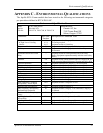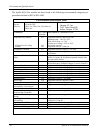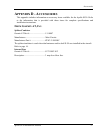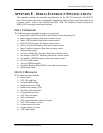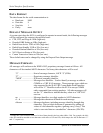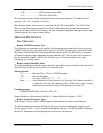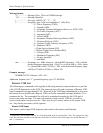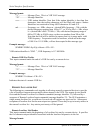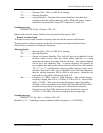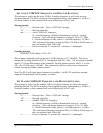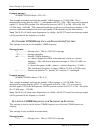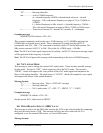
Serial Interface Specifications
62 Apollo SL30 Installation Manual
Message format:
“C” .................Message Class. This is a COMM message.
“05”................Message Identifier.
t ......................List type: (ASCII) “0”, “1”,…, “9”
f......................Frequency type: 0-Fh; use encoded hex
2
(30h-3Fh).
0 = Tower Frequency (TWR)
1 = Ground (GND)
2 = Automatic Terminal Information Service or ATIS (ATS)
3 = Air Traffic Frequency (ATF)
4 = Approach (APP)
5 = Arrival (ARR)
6 = Automatic Weather Observing Station (AWS)
7 = Clearance/Delivery (CLR)
8 = Common Traffic Advisory Frequency (CTF)
9 = Departure (DEP)
: = Flight Service Station (FSS)
; = Remote Flight Service Station (RFS)
< = Unicom (UNI)
= = Mandatory Frequency (MF)
> = No type specified
? = undefined
mk ..................Frequency: m = MHz, where m = desired MHz frequency – 30h, with the
desired frequency ranging from 118 to 136, or 46h to 48h; k = kHz, where
k = (desired kHz offset / 25 kHz) + 30H, with the desired frequency range
of 000 to 975 kHz in 25 kHz, or 30h to 57h.
Example message:
$PMRRC0511IT<chksum><CR><LF>
Additional frequency list “1”, ground frequency type, 121.900 MHz.
REMOTE VOR LIST
The following two commands work together in allowing remotely connected devices to provide
a list of VOR frequencies to the SL30. The remote device will send a sequence of Remote VOR
Input commands (message identifier 20). When all of the VOR Input commands have been sent,
the remote device should send a Remote VOR List Trailer command (message identifier 21) to
terminate the list. The transmitted list will not be considered complete by the SL30 until it
receives the trailer message. The unit will maintain a single remote VOR list, so each list
received will replace any previous list. There may be up to twenty entries in the remote VOR
list. Any entries past twenty will be ignored.
Remote VOR Input
This input is used to input VOR frequency data used for the remote recall function.
2
Encoded hex: each character consists of a 4-bit data placed in the low order nibble +30h. For example, the 8-bit
value 5Fh would be encoded as two characters with values of 35h and 3Fh, which map to the ASCII characters “5”
and “?”, respectively.




